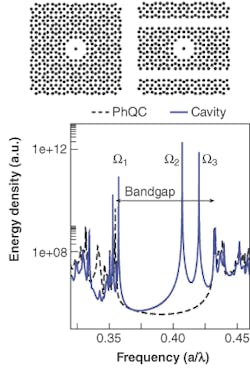Add/drop filters that add or remove very narrow wavelengths of light from a broader optical signal being carried down a waveguide have been demonstrated in 2-D photonic crystals (PCs) with a complete photonic bandgap (PBG). Versions of this type of device have been made using silicon, for example, whose relatively high refractive index of 3.5 can be considered not compatible with the low-index materials common in optical telecommunications (optical fibers are made of silica, with a refractive index of 1.5).
An alternative to PCs in this application is the family of photonic quasicrystals (PQCs), which can exhibit a complete PBG without requiring materials with a high refractive-index contrast. A team of researchers from the Tyndall National Institute at the University College Cork (Cork, Ireland), Universität Bonn (Bonn, Germany), and the Technical University of Denmark (Lyngby, Denmark) has demonstrated how a PQC can be a suitable platform for development of an add/drop filter.1 The research was partly funded by the European Commission IST project APPTech, the German Ministry of Education and Research project PCOC and the Science foundation of Ireland.
Photonic quasicrystals are PCs that have scattering centers located in the vertices of a quasiperiodic tiling of space; they have neither true periodicity nor translational symmetry, but have quasiperiodicity with a long-range order and orientational symmetry. Octagonal (eightfold), decagonal (tenfold), and dodecagonal (12-fold) symmetries for PQCs have been studied and indicate that these symmetries have wide complete bandgaps and a small threshold value of refractive index for opening a complete gap.
Eightfold symmetry
For the add/drop application, the researchers studied the optical properties of an octagonal lattice of dielectric rods that possesses a full PBG in transverse-mode polarization (electric field parallel to the rod axes), uses low-index materials, and does not require resizing of rods or inclusion of other elements, thus substantially simplifying the fabrication process.
The basic building blocks of an add/drop filter are high-quality—factor microcavities to provide coupling between waveguide channels. The researchers defined a microcavity inside a square path of PQC by removing two layers of rods around the one located at the geometrical center of the system (see figure). The microcavity supports quadrupole, hexapole, and dipole modes in finite sets (or doubly degenerate modes)—the ideal building block for an add/drop filter. Next, the researchers created a PQC waveguide by removing one or several rows of rods. Finally, integration of the microcavity and waveguide produced a PQC add/drop filter.
While the device demonstrated by the researchers shows nearly 100% dropping efficiency and a quality factor close to 700, the overall transmission is fairly small-only 15% of the incident power. The proposed add/drop filter would need to be significantly improved before it can be used for optoelectronics applications. One method of improvement is to use an adiabatic coupler at the input channel to suppress back-reflection due to impedance mismatch. The irregular shape of the PQC boundaries makes the impedance-matching conditions at the air-PQC interface challenging; however, the researchers were able to show that a lattice cut with a plane interface can raise the transmission to 50% of the incoming signal intensity in the spectral region of interest and reduce the crosstalk to the forward-drop channel from 50% to only 20%.
The researchers believe this is the first such demonstration using a dielectric constant of 5.0 (n = 2.24). "We consider our results the first "proof-of-principle" demonstration of a photonic integrated component based on the photonic-bandgap effect using materials with such a low refractive index. Of course, much additional research and development is necessary to bring such a component to the market," says researcher Dmitry Chigrin. "As a first step toward telecommunications applications, one should redesign the structure using silica or polymer materials. In contrast with photonic crystals, our structure possesses a relatively large bandgap of 5% to 6% in this case, so we are quite optimistic about the prospect of the proposed structure based on silica. This work is in progress."
Postgraduate researcher Javier Romero-Vivas says future plans include simulation of their device using a full 3-D model to help understand the scattering and substrate losses and to aid in developing an optimum design. Coupling to conventional optical waveguides will also be addressed, with the eventual possibility of realizing the proposed filter using nanoimprint lithography.
REFERENCE
1. J. Romero-Vivas et al., Optics Exp. 13(3) 826 (Feb. 7, 2005).
About the Author

Gail Overton
Senior Editor (2004-2020)
Gail has more than 30 years of engineering, marketing, product management, and editorial experience in the photonics and optical communications industry. Before joining the staff at Laser Focus World in 2004, she held many product management and product marketing roles in the fiber-optics industry, most notably at Hughes (El Segundo, CA), GTE Labs (Waltham, MA), Corning (Corning, NY), Photon Kinetics (Beaverton, OR), and Newport Corporation (Irvine, CA). During her marketing career, Gail published articles in WDM Solutions and Sensors magazine and traveled internationally to conduct product and sales training. Gail received her BS degree in physics, with an emphasis in optics, from San Diego State University in San Diego, CA in May 1986.
